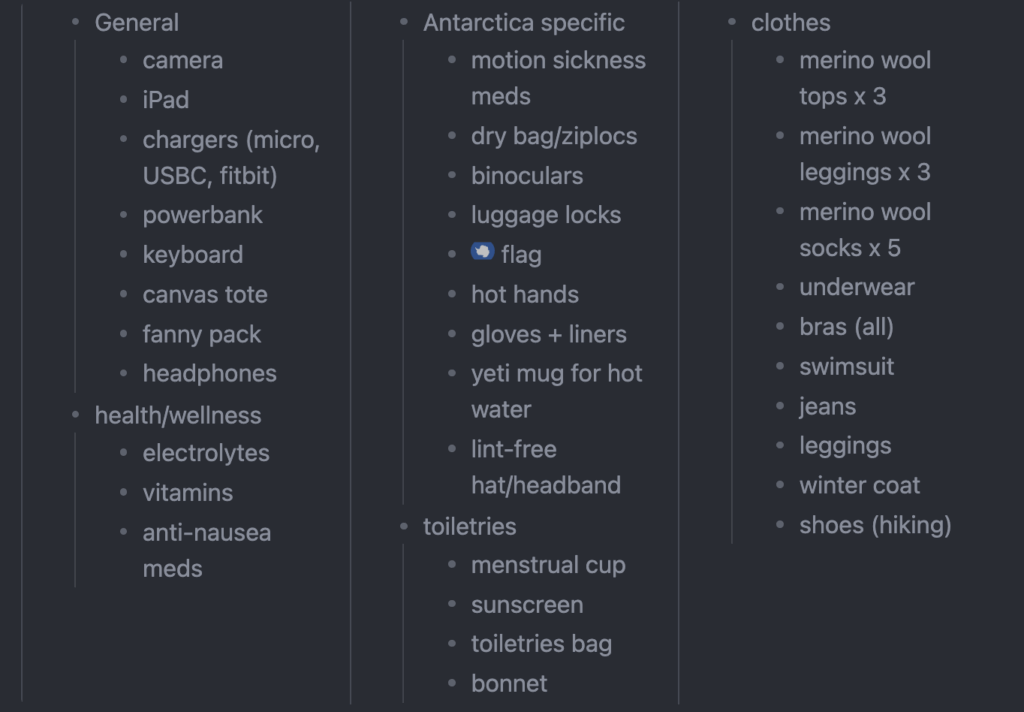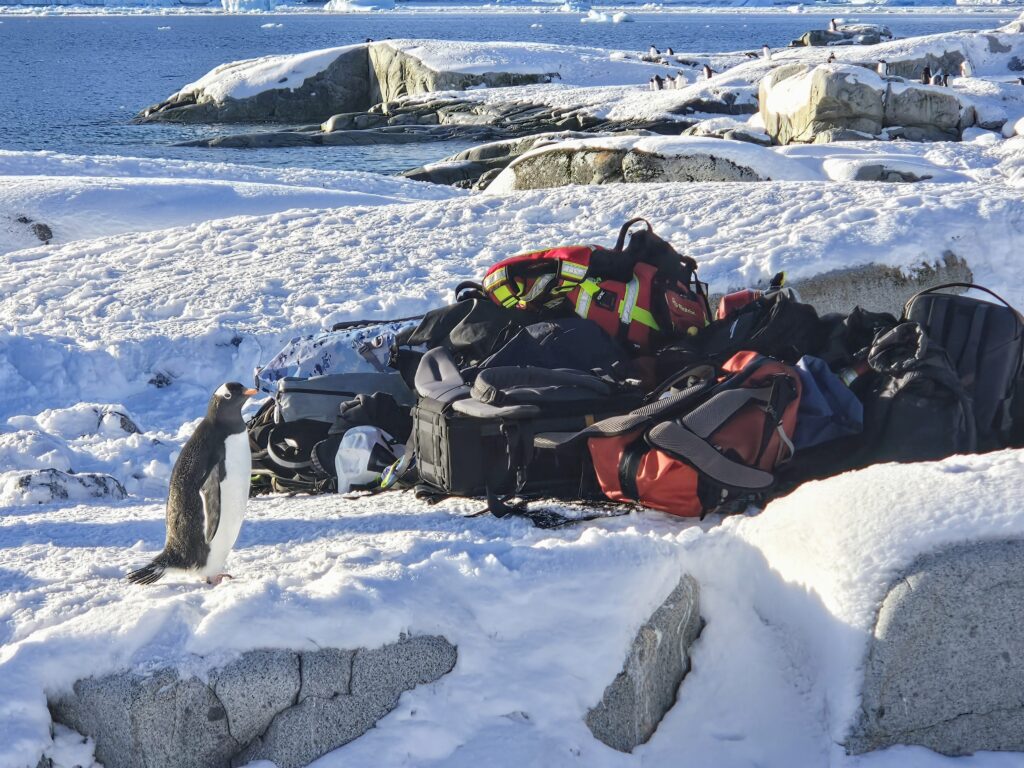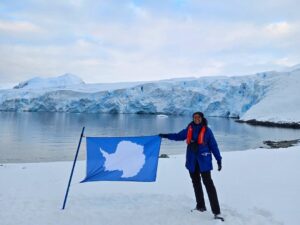My path to Antarctica also included a brief stint in Ushuaia, though the climates are not overly different. This journey ventured through a number of situations, the most extreme of which were entirely foreign to me. This post concerns just the planning and packing portions of this arduous and amazing journey. It is also the last of the posts about this once in a lifetime trip!
.
the literal path to Ushuaia
Most ships to Antartica depart from Ushuaia, Tierra del Fuego, Argentina. If Antarctica is other-worldly, it makes sense that Ushuaia is nicknamed “The End of the World” (El fin del mundo in Spanish.) The town is sandwiched in the Southern Atlantic islands and is further isolated by the magnificent Patagonian mountains. The (cursed) Mercator projection distorts how far away Ushuaia is from everything. Many people choose to book flights directly from their home airports to Ushuaia, but they often contain an intra-city transfer in Buenos Aires. International flights primarily arrive/depart from Buenos Aires’ international airport (EZE), whereas flights to Ushuaia depart from their Mercosul-centered airport (AEP.)
Passengers have to arrange transfers themselves, and that was something I was not willing to do for a few reasons: my portuñol is not great, traffic is unpredictable, and I don’t want to navigate Buenos Aires. I ended up booking a round-trip flight to São Paulo and a second round-trip from there to Ushuaia. This itinerary allowed me to fly Star Alliance for the majority of the trip, save $800, and worry only about getting to another terminal within Guarulhos. I did budget 12 hours between tickets, and that time was more than sufficient.
Out of fear of missing boats/planes, I budgeted three buffer nights before and one after in Ushuaia. While arriving two nights before would’ve been nice to acclimate, I definitely allotted too much time in Ushuaia. Leaving the day of disembarkation also would have been preferable. Because docking in Ushuaia is expensive, crews are rarely (if ever) late to port and often arrive early, as mine did the night before. These expeditions run a tight ship!
.
expeditions vs. cruises
Cruises largely take place on ships with many amenities like spas, arcades, etc. They’re also considerably bigger than expedition ships, which has pros and cons. In Antarctica cruises must maintain greater distances with land and docks and take more consideration with navigation and landings. Passengers on cruise ships will also generally fare better with seasickness since they rock less.
Expedition ships have ice-strengthened hulls and staff trained in zodiac navigation as well as naturalists familiar with the environment. Some expeditions are also equipped to camp, trek, kayak, ski, and do various other activities. In general, expeditions seem to be for the more adventurous and mobile, which was a great fit for me.
I’m not sure I can overstate how little research I did for this trip. My decision ended up being made primarily by the emphasis of the Southern Lights (Aurora Australis) in the trip title more than any other factor. Thankfully I have no regrets about my decision and felt even more vindicated after comparing notes with other passengers.
.
how to bundle up
Antarctica is quite literally the least inhabitable and most hostile land on Earth. It’s easy to assume that it’s another winter destination, but it’s a bit more aggressive than a ski holiday. Most operators provide packing list recommendations for their passengers to account for this. I included much of their list in mine (pictured at the end of this post), and I’m glad because this trip was more than a cruise: it was an expedition.
Expeditions are far more unpredictable than cruises because they’re inherently more exploratory. This trip also ventured south of the polar circle, meaning extreme weather events were more probable. We were told to hope for the best, but plan for the worst—up to and including being stranded on Antarctic lands, unable to reach ship.
This meant that in addition to waterproof shells, we needed base layers, face coverings, dry bags, and the ability to secure all possessions to our bodies. Many photographers on the trip also brought their equipment, covers, and dry bags to protect their devices and batteries from the harsh weather. Most of them also brought computers and external drives to back up their photos immediately in the event they lost their equipment to the sea.
.
mistakes in packing
Though I have packing almost down to a science, I would be lying if I said I absolutely nailed my packing for this trip. There are various odds and ends I definitely wish I knew/brought, including:
- Argentina’s outlets are like AUS/HK outlets, not like EU outlets. This was not an issue on the ship, but of note in Ushuaia
- Mini carabiners and a phone/camera lanyard: during landings in Antarctica, items must be secured to yourself or bag. This is partially for biosecurity, and partially so you don’t lose your phone to the sea
- Close-toed comfy shoes with a back strap: passengers must wear these safe shoes at all times on the boat, and it becomes evident why when you hit the Drake passage. I wish I had something other than my running shoes, like slippers or boat shoes.
- Moisturizers and vaseline: the wind, sun, and air conspire to dry out your skin. I definitely wish I packed extra lotion and vaseline to help in the recovery, especially after windy and sunny zodiacs
- Cold medicine, emergen-C, and/or airborne: while I was careful about my health before leaving, other passengers were not and I came down with a nasty cold. There’s no pharma-sea, so I just suffered and drank orange juice, but I would’ve loved a decongestant.
- SD card reader, data storage, and USB cables: I thankfully could use my phone a makeshift data storage device for the guest photo shares/transfers, but I didn’t realize I can use an SD card reader to directly transfer photos from my camera to my phone.
- A hiking stick: for the unbalanced and unpracticed in steep snow and mud
- Magnetic hooks and a cable line or shoelace: line drying my hand washed socks and underwear would’ve been much easier if I had a line, but I made do with hangers.
.
blessings in preparation
While my 100L water-resistant duffel bag seemed a bit excessive when I departed, I was very thankful for the extra space when I returned. Souvenirs don’t usually tempt me so much, but I had to commemorate this trip. Other passengers also brought gifts, including Antarctic-themed playing cards and stickers. Some people also had issues with the natural expansion of things when you’re rushing to checkout on time.
In the week before my departure, I read a couple of packing lists and was thankful I packed several things:
- data cable for my phone to USB-A: to get photos from the (Windows) computers in the bar areas
- my Yeti mug: I drank copious amounts of tea, and was able to enjoy it longer and across the ship
- (rented) jacket: my Chicago winter coat was warm enough for this weather, but it did not have the pockets or the hood ideal for expeditioning
- hot hands: hours on land and on the zodiacs can zap your body heat, especially when taking pictures. Hot hands absolutely saved my hands on a few excursions, and could also save cold feet
- tablet + keyboard: I wanted to write while on the trip and a (foldable) full-size keyboard is a must
.
bringing it home
For those well versed in nature expeditions, Antarctica isn’t too different from any other trip. There were plenty of passengers who didn’t buy/rent anything new for this trip, but they were more experienced with this sort of trip. Supplies are also harder to get in both Argentina and on the ship. The ship’s shop only has limited supplies, and (shocker!) there’s no shopping on the white continent. Still, the most important thing to bring is a flexible and adventurous spirit, because the winds can blow your trip in so many directions.
.
my non-exhaustive packing list
for those curious!


![Planning and packing for after the end of the world [Ushuaia and Antarctica]](https://selam.fyi/wp-content/uploads/sites/2/2025/05/portrait_aq_bags-scaled.jpeg)


